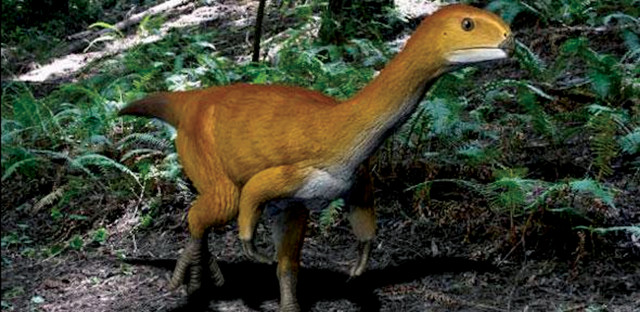
by Mary Caperton Morton Wednesday, November 15, 2017

Chilesaurus, which lived during the Late Jurassic, was an early ornithiscian dinosaur that shared traits with other ornithischians as well as with theropods, according to new research. Credit: Nobu Tamura.
In 2015, a new dinosaur was discovered in southern Chile, but its odd set of characteristics left paleontologists scratching their heads: Was it a carnivore or an herbivore? A closer look at the bones of the dinosaur, named Chilesaurus, is helping scientists determine how it fit into the Late Jurassic landscape.
The enigmatic Chilesaurus has a head similar in shape to that of the predatory Velociraptor, but its teeth are flat and appear more suited to grinding up plant matter than tearing flesh. “Chilesaurus almost looks like it was stitched together from different animals, which is why it baffled everybody,” said Matthew Baron of the University of Cambridge in England and a co-author of a new study in Biology Letters in a statement. “Its weird mix of features places it in a key position in dinosaur evolution and helps to show how some of the really big splits between the major groups might have come about,” added co-author Paul Barrett of London’s Natural History Museum.
Originally, Chilesaurus was classified into the dinosaur group Theropoda, which includes so-called “lizard-hipped” dinosaurs like Velociraptors and tyrannosaurs. In the new study, however, after analyzing more than 450 anatomical features of early dinosaurs and dinosaur-like animals, Baron and Barrett found that Chilesaurus is a very early member of Ornithischia, the group of “bird-hipped” dinosaurs that includes large herbivores such as Stegosaurus and Triceratops. Nonetheless, Chilesaurus seems to be something of a transitional species, with a bird-like hip structure and other characteristics of herbivorous ornithischians but lacking the distinctive “beak” seen in many species in the group. The results suggest that Chilesaurus slots into the large gap between the known members of Theropoda and Ornithischia, the team wrote.
“Before [Chilesaurus], there were no transitional specimens — we didn’t know what order these characteristics evolved in,” Baron said. The team suggested that bird-like hips may have allowed for more complex plant-consuming digestive systems to evolve, which in turn led to larger herbivorous ornithischians. “This [work] shows that in bird-hipped dinosaurs, the gut evolved first, and the jaws evolved later — it fills the gap quite nicely,” Baron said.
© 2008-2021. All rights reserved. Any copying, redistribution or retransmission of any of the contents of this service without the expressed written permission of the American Geosciences Institute is expressly prohibited. Click here for all copyright requests.